| Dust Storm (Manter, Kansas) | |
|---|---|
 | |
| Artist | John Gerrard |
| Year | 2008 |
| Type | 3D video environmental art |
| Location | Irish Museum of Modern Art, Dublin |
Dust Storm (Manter, Kansas) is a 3D digital simulation work of art, by John Gerrard.
| Dust Storm (Manter, Kansas) | |
|---|---|
 | |
| Artist | John Gerrard |
| Year | 2008 |
| Type | 3D video environmental art |
| Location | Irish Museum of Modern Art, Dublin |
Dust Storm (Manter, Kansas) is a 3D digital simulation work of art, by John Gerrard.
In 2008, the Dust Storm was shown at Artropolis, Chicago. In 2011, it was shown at PICA, Perth, Australia, Ivorypress, Madrid, Spain, and Irish Museum of Modern Art.
The 3D "hyperreal" portraits depict beautiful landscapes. [1]
Dust Storm unites a classic image from the Great Depression with a contemporary industrial landscape, setting them in a cosmological orbit that is completed over the full spectrum of a year. The exploitation of oil that goes back to the beginning of the 20th Century is presented as the catalyst of conditions that led to the ecological disaster of the Dust Bowl. But nothing is didactic. The pity in the subject comes to viewers subliminally through a visual poem of complexity and power. [2]

The Dust Bowl was the result of a period of severe dust storms that greatly damaged the ecology and agriculture of the American and Canadian prairies during the 1930s. The phenomenon was caused by a combination of natural factors and human-made factors: a failure to apply dryland farming methods to prevent wind erosion, most notably the destruction of the natural topsoil by settlers in the region. The drought came in three waves: 1934, 1936, and 1939–1940, but some regions of the High Plains experienced drought conditions for as long as eight years.

Stanton County is a county located in the U.S. state of Kansas. Its county seat is Johnson City. As of the 2020 census, the county population was 2,084. It was named for Edwin Stanton, the U.S. Secretary of War during most of the American Civil War.
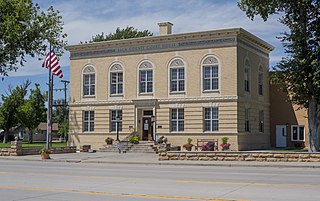
Baca County is a county located in the U.S. state of Colorado. As of the 2020 census, the population was 3,506. The county seat is Springfield. Located at the southeast corner of Colorado, the county shares state borders with Kansas, New Mexico, and Oklahoma.
A storm is any disturbed state of the natural environment or the atmosphere of an astronomical body. It may be marked by significant disruptions to normal conditions such as strong wind, tornadoes, hail, thunder and lightning, heavy precipitation, heavy freezing rain, strong winds, wind transporting some substance through the atmosphere such as in a dust storm, among other forms of severe weather.

The M65 is a motorway between Preston and Colne in Lancashire, England. It runs from Bamber Bridge just south of Preston, through major junctions with the M6 and M61 motorways, east past Darwen, Blackburn, Accrington, Burnley, Brierfield, Nelson and ends at Colne.
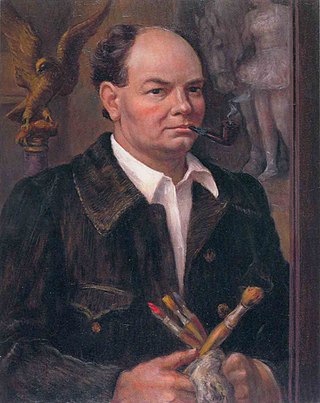
John Steuart Curry was an American painter whose career spanned the years from 1924 until his death. He was noted for his paintings depicting rural life in his home state, Kansas. Along with Thomas Hart Benton and Grant Wood, he was hailed as one of the three great painters of American Regionalism of the first half of the twentieth century. Curry's artistic production was varied, including paintings, book illustrations, prints, and posters.
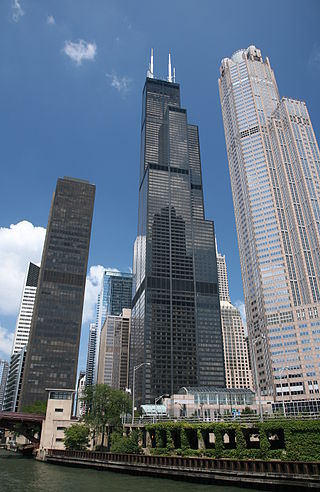
The buildings and architecture of Chicago reflect the city's history and multicultural heritage, featuring prominent buildings in a variety of styles. Most structures downtown were destroyed by the Great Chicago Fire in 1871.
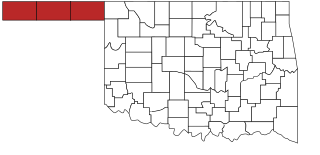
The Oklahoma Panhandle is a salient in the extreme northwestern region of the U.S. state of Oklahoma. It consists of, from west to east, Cimarron County, Texas County and Beaver County. As with other salients in the United States, its name comes from the similarity of its shape to the handle of a pan. Its largest city is Guymon in Texas County. Black Mesa State Park, located in Cimarron County, is the highest point in the state. Other points of interest include Beaver Dunes Park, Optima Lake, and the Optima National Wildlife Refuge. Oklahoma Panhandle State University is ten miles away from Guymon.

Storm King Art Center, commonly called Storm King and named for nearby Storm King Mountain, is an open-air museum in New Windsor, New York. It contains perhaps the largest collection of contemporary outdoor sculptures in the United States. Founded in 1960 by Ralph E. Ogden as a museum for Hudson River School paintings, it soon became a major sculpture venue with works from some of the most acclaimed artists of the 20th century. The site covers about 500 acres, and is located about a one-hour drive north of Manhattan.
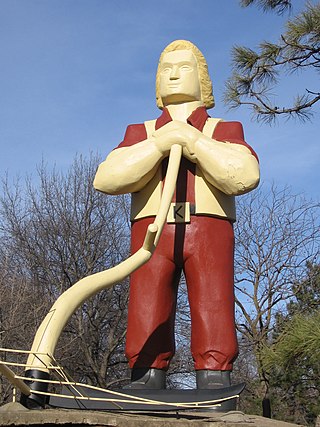
Johnny Kaw is a fictional Kansas settler and the subject of a number of Paul Bunyan-esque tall tales about the settling of the territory.

Planum Boreum is the northern polar plain on Mars. It extends northward from roughly 80°N and is centered at 88.0°N 15.0°E. Surrounding the high polar plain is a flat and featureless lowland plain called Vastitas Borealis which extends for approximately 1500 kilometers southwards, dominating the northern hemisphere.

Wilbur Wright College, formerly known as Wright Junior College, is a public community college in Chicago. Part of the City Colleges of Chicago system, it offers two-year associate's degrees, as well as occupational training in IT, manufacturing, medical, and business fields. Its main campus is located on Chicago's Northwest Side in the Dunning neighborhood.

Black Sunday is a particularly severe dust storm that occurred on April 14, 1935, as part of the Dust Bowl in the United States. It was one of the worst dust storms in American history and caused immense economic and agricultural damage. It is estimated that 300 thousand tons of topsoil were displaced from the prairie area.

The Diacria quadrangle is one of a series of 30 quadrangle maps of Mars used by the United States Geological Survey (USGS) Astrogeology Research Program. The quadrangle is located in the northwestern portion of Mars' western hemisphere and covers 180° to 240° east longitude and 30° to 65° north latitude. The quadrangle uses a Lambert conformal conic projection at a nominal scale of 1:5,000,000 (1:5M). The Diacria quadrangle is also referred to as MC-2. The Diacria quadrangle covers parts of Arcadia Planitia and Amazonis Planitia.

Eyarth railway station served the village of Llanfair Dyffryn Clwyd in Denbighshire, Wales, between the years of 1864 and 1962. It is located west off an unnamed minor road of off Wrexham road south of Ruthin. It had one platform and a goods loop at the end. The station house is now a Bed and Breakfast and part of the platform still exists,
John Gerrard, is an Irish artist, best known for his sculptures, which typically take the form of digital simulations displayed using real-time computer graphics.

Saddle is a 1993 surrealist sculpture by Irish artist Dorothy Cross. It is in the collection of the Irish Museum of Modern Art having been acquired in 1994. It is created by the combination of found objects - specifically a metal frame, a horse's saddle and an upturned cow's udder. Virgin's Shroud, another work by Cross from 1993, also features cow's udders and is in the collection of the Tate.
It was perhaps no surprise to soon come upon the Freudian play of Dorothy Cross’ Saddle...There is something doubly unsettling about udders. On the one hand they remind me of large elongated nipples, which they are, and on the other they have a resemblance of a small thick penis. The Saddle also has a reference to the arse and so, all in all, the piece has a fascinating desire to confuse and unsettle, to engage and perturb.

The Berry Dress is a 1994 mixed media sculpture by Alice Maher.
A dust storm is a meteorological phenomenon in which strong winds move loose sand and dirt.

Tornado over Kansas is a 1929 oil-on-canvas painting by the American Regionalist painter John Steuart Curry. It depicts a dramatic scene in which a family races for shelter as a tornado approaches their farm, and has compositional connections to Curry's earlier 1928 painting Baptism in Kansas. The artist is believed to have been influenced by Baroque art and photographs of tornadoes. He developed a fear of natural disasters and a reverence towards God during his childhood, both of which are apparent in the painting.
53°20′24″N6°17′59″W / 53.3400°N 6.2997°W